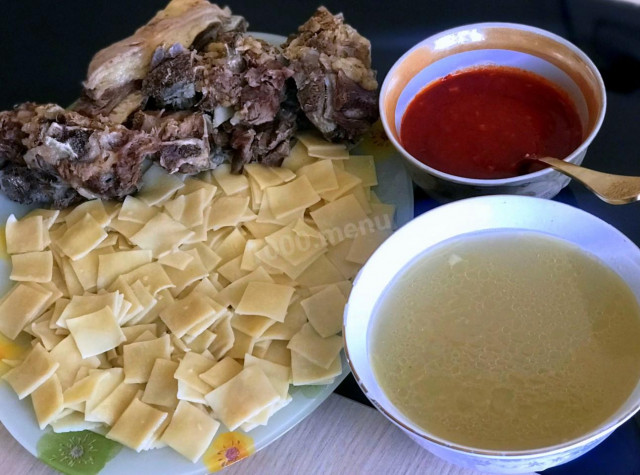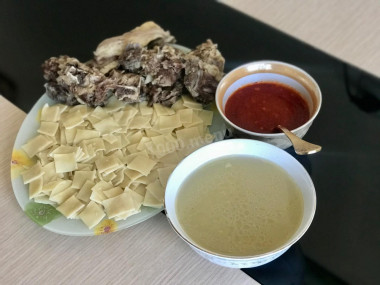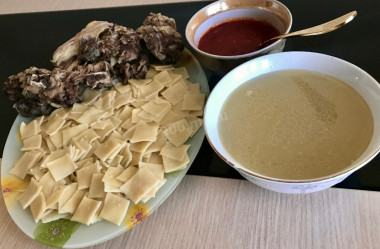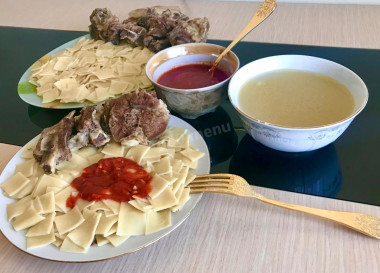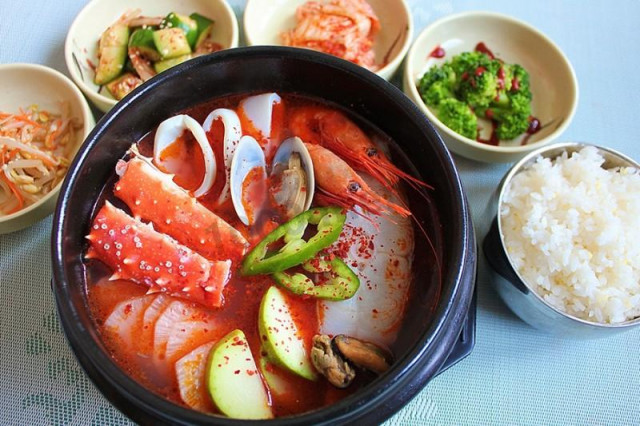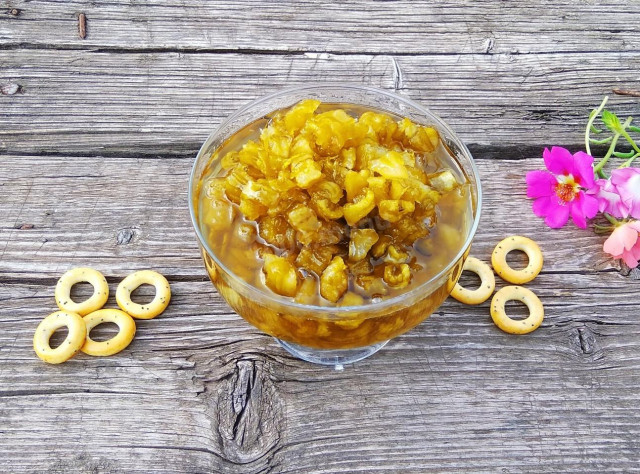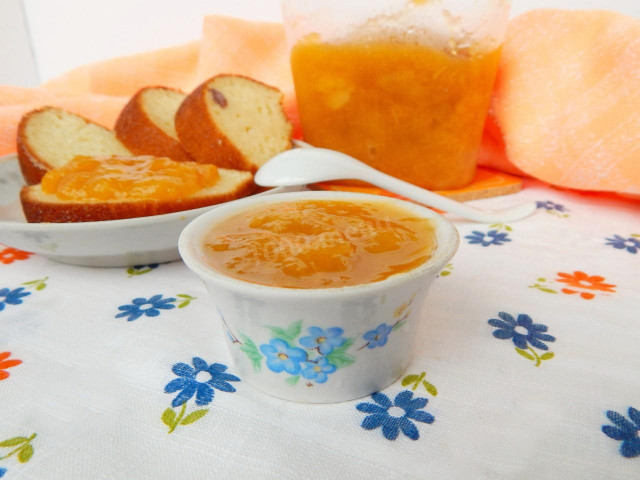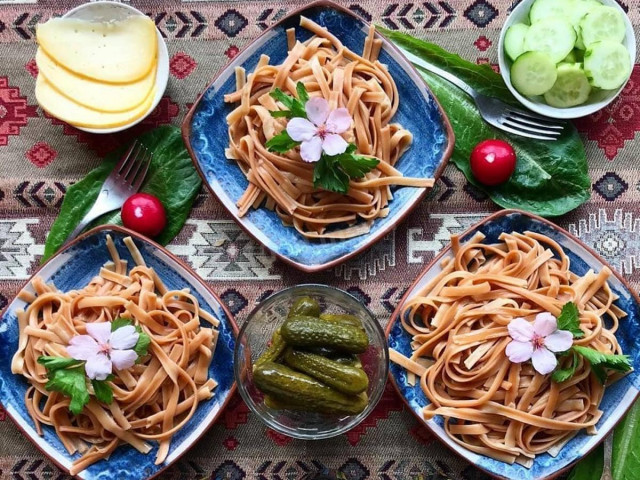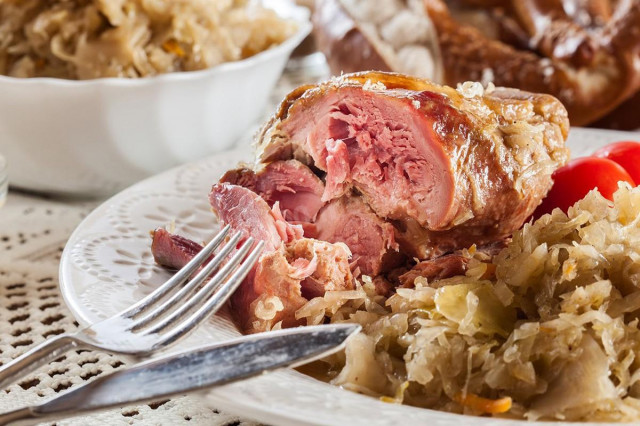Composition / ingredients
Cooking method
Be sure to try this version of hinkal! The smell will be all over the house, the aroma of meat broth in a compartment with the smell of tomato-garlic sauce and raises the appetite!
In the course of cooking, I will give advice, and also at the end I will tell you a couple of tricks and quick cooking options.
Step 1. Put the meat to cook until fully cooked. It cooks for about 2 hours, and the cooking time depends on the hardness of the meat.
At the beginning, pour 3 liters of water into a saucepan, and after an hour another 2 liters. It is necessary to salt the meat broth 20-25 minutes before the end of cooking, when the meat is not yet completely cooked. This is done so that the meat does not become tough. To taste, you can add a pinch of pepper and 3 bay leaves, especially well combined with chicken.
Step 2. Cooking tomato sauce. To do this, heat the frying pan, pour 30 ml of vegetable oil (about 2 tablespoons), heat and then add 50 grams of tomato paste (2 tablespoons). Fry until a pleasant smell comes and the paste almost darkens. After adding the broth about 250 ml (1 cup), mix. Add the broth a little at a time so that the sauce does not turn out too liquid. Cook the sauce for 2-3 minutes and pour it into a bowl. Add 5 cloves of garlic and a pinch of salt to it. Garlic is passed through a garlic press, if it is not there, then you can rub it on a fine grater or chop it finely with a knife.
Step 3. Knead the dough for 30-40 minutes until the meat is ready. To do this, add 1 egg and 1 tablespoon of salt to the flour without a slide, about 400-430 ml of water will be useful, knead until smooth. The dough should be cool.
Cover with a kitchen towel and let stand for 5-10 minutes. If not covered, a film forms on the dough, and we leave it for a few minutes so that the dough is easier to roll out.
Step 4. Divide the dough into 2 parts, form the dough parts into 2 balls. One ball is covered and removed, and the second is placed on the work surface and left for a couple of minutes.
Important! Sprinkle enough flour on the board so that the dough does not stick.
Roll out the dough thinly, the thickness is about 1 mm, and I got 68 cm in diameter. After cutting with a knife into squares, that is, first draw vertical lines along the dough sheet, then horizontal. That's how our khinkalins turned out)!
Step 5. As soon as the meat is cooked, we take it out with a slotted spoon on a plate. It is better to strain the broth through a fine strainer. I do this so that in the end the hinkal turns out to be cleaner, otherwise on a white background all sorts of small remnants look very untidy. If there is no strainer, then you can pour the broth into a deep bowl. After 2-3 minutes, carefully pour the broth back into the pan so that nothing superfluous from the bottom of the bowl does not fall.
Step 6. To cook khinkalin, there should be enough water in the pan so that they do not stick to the bottom. If most of the water has boiled off, then add another 1 liter of water.
Taste the broth, add salt at your discretion. Cover with a lid and wait until the broth boils. After boiling, add the chopped khinkali and be sure to mix so that they do not stick together, then close the lid and wait until it boils again, mix. Cook for 3-5 minutes. Personally, I cook for 3 minutes, because I don't like when the khinkalins boil and become soft, and some on the contrary like it. Therefore, during cooking, we take out a couple of pieces and try. It is necessary to remove the hincalines with a slotted spoon quickly so that they do not soften much.
Step 7. Serve immediately after cooking with tomato-garlic sauce, a piece of meat and broth in a bowl.
To taste, you can add a little butter. Bon appetit!
Bonuses:
1. The sauce option is for those who do not like garlic or problems with the gastrointestinal tract do not allow it to be consumed. Garlic is not added to the tomato sauce, but we prepare two sauces. In one bowl, fried tomato paste with the addition of broth and salt, and in the second broth with the addition of a pinch of salt and garlic. This is done so that the rest of the family can try this dish with garlic sauce.
2. Knead the dough with the expectation of a couple of servings more. We leave the finished squares of dough to dry, then put them in a bag and store them in the kitchen in the closet. Next time it will be possible to cook them, if the dough was not calculated and it turned out to be a little hinkal, or suddenly the guests came. I want to note that dried khinkali will cook for a couple of minutes longer.
3. You can also make hinkal with minced meat and egg from them. To do this, first cook the minced meat in a saucepan with a small amount of water, then fry with the addition of eggs and finely chopped onions. We cook the khinkalins in salted water.
Recipe of hinkal with minced meat I will add to myself soon).
Caloric content of the products possible in the composition of the dish
- Melted beef fat - 871 kcal/100g
- Fat beef - 171 kcal/100g
- Lean beef - 158 kcal/100g
- Beef brisket - 217 kcal/100g
- Beef - okovalok - 380 kcal/100g
- Beef - lean roast - 200 kcal/100g
- Beef shoulder - 137 kcal/100g
- Beef - ribs - 233 kcal/100g
- Beef - ham - 104 kcal/100g
- Beef - tail - 184 kcal/100g
- Boiled ham - 269 kcal/100g
- Beef corned beef - 216 kcal/100g
- Chicken egg - 157 kcal/100g
- Egg white - 45 kcal/100g
- Egg powder - 542 kcal/100g
- Egg yolk - 352 kcal/100g
- Ostrich egg - 118 kcal/100g
- Garlic - 143 kcal/100g
- Vegetable oil - 873 kcal/100g
- Tomato paste - 28 kcal/100g
- Salt - 0 kcal/100g
- Water - 0 kcal/100g
- Wheat flour - 325 kcal/100g
- Meat broth - 34 kcal/100g

